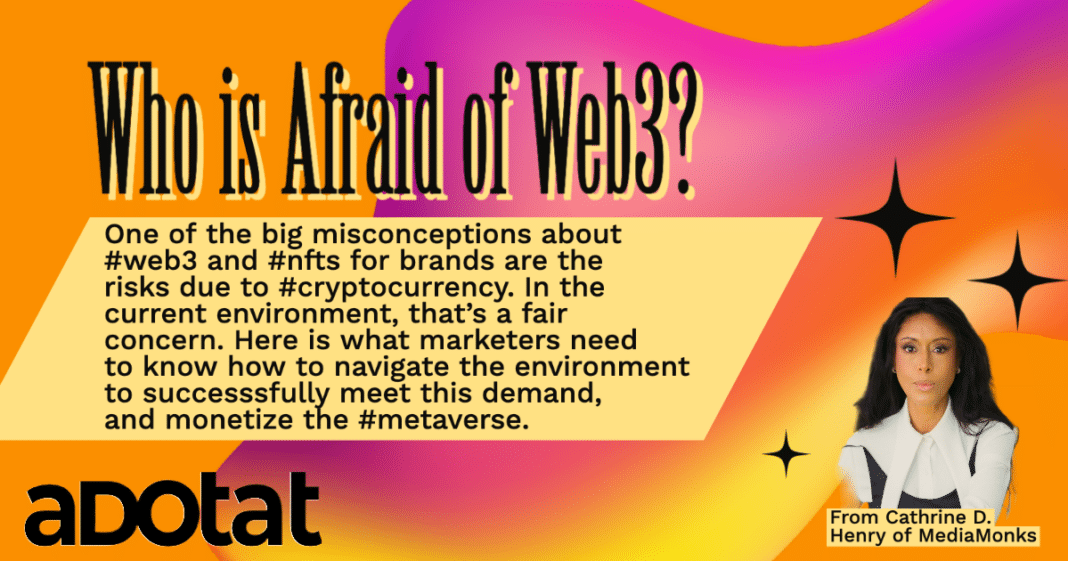One of the big misconceptions about #web3 and #nfts for brands are the risks due to #cryptocurrency. In the current environment, that’s a fair concern. Here is what marketers need to know how to navigate the environment to successsfully meet this demand, and monetize the #metaverse:
1. Blockchain is different from digital currency. Digital currency is just of the numerous potential uses of Blockchain.
Blockchain technology is a system for recording transactions that has no central database. It’s a distributed, immutable ledger that can be used to record transactions among multiple parties in real time. This means that it allows parties to transfer assets or data without relying on a third party or middleman (like a bank).
2. NFT’s: An NFT is a blockchain token that can represent ownership in a unique digital item, such as a profile picture (PFP) or avatar, collectibles, and digital clothing. It does not need to be issued or purchased with crypto (indeed, to scale, fiat is better). And you dont have to call them NFT’s.
An NFT is an immutable token that represents ownership in a unique digital item. The digital item can be anything from an avatar on a social network to a profile picture on Twitter that has been gifted by someone else. These tokens are also called non-fungible tokens because each one of them is unique.
As opposed to fungible tokens like bitcoin or ether which are interchangeable and can be traded for any other unit of the same currency type.
3. CRM: Starbucks is one of the most popular brands in the world, and it’s because they are constantly innovating their brand experience. Their loyalty program is an excellent example of this: In addition to rewarding customers with a free drink after they purchase 12, they’ve also been able to use NFTs to create unique experiences for their customers. For example, if you buy a Frappuccino with your app at Starbucks, you’ll get another one for free on your birthday!
Starbucks’ loyalty program has been so successful because it has proven that CRM needs a comprehensive NFT strategy. As digital touchpoints between consumers and brands become more important than ever before, brands need to be able to understand how consumers interact with their products—and how those interactions can be improved.
The best way to do this is by experimenting with new technologies like NFTs and blockchain-based platforms that can help provide access to data without compromising security or privacy.
Similarly, #Nike showed its commitment to the space by creating the .swoosh marketplace to make digital collectibles more accessible. “We are shaping a marketplace of the future with an accessible platform for the web3-curious,” said Ron Faris, VP Nike Virtual Studios. “In this new space, the .SWOOSH community and Nike can create, share, and benefit together.”
It would be short-sighted for brands to abandon NFTs after a much-needed market correction. In fact, the recent market correction is a great opportunity for brands to get involved in NFTs before they become completely mainstream.
Brands can use this time to educate themselves on the space and how it will affect their business, while also creating partnerships with other brands that have already established themselves as leaders in this area.
Blockchain and other digital assets have the potential to open up a new world of possibilities in the Metaverse. Just as payment systems on websites opened up e-commerce to all the transactions we make online each day, so too will blockchain make it possible for people to interact with each other face-to-face in virtual environments.
And who is at the forefront of this trend? Generation Z (Gen Z), whose members will comprise the largest income bracket in the world by 2030. They’re already embracing digital assets like bitcoin and ethereum, trading NFTs for fun, so it seems likely that they’ll also be among the first to embrace VR/AR technology.
The world is changing, and fast.
That’s especially true for the world of marketing. If you want to capture these new trends and technologies, you need to be willing to wait things out a little—and you need a flexible strategy that lets you get there.
With so much going on in the tech space, it can be tempting to jump straight into new tools and channels. But if you’re not careful, you can lose sight of the big picture: what your brand stands for and what kind of impact you want to have on the world.
That’s where patience comes in. Patience is one of those words that gets thrown around a lot, but it’s not always clear what it means. In this case, we’re talking about having the patience to invest in a flexible strategy that will help you adapt over time—even as new trends and technologies emerge.










